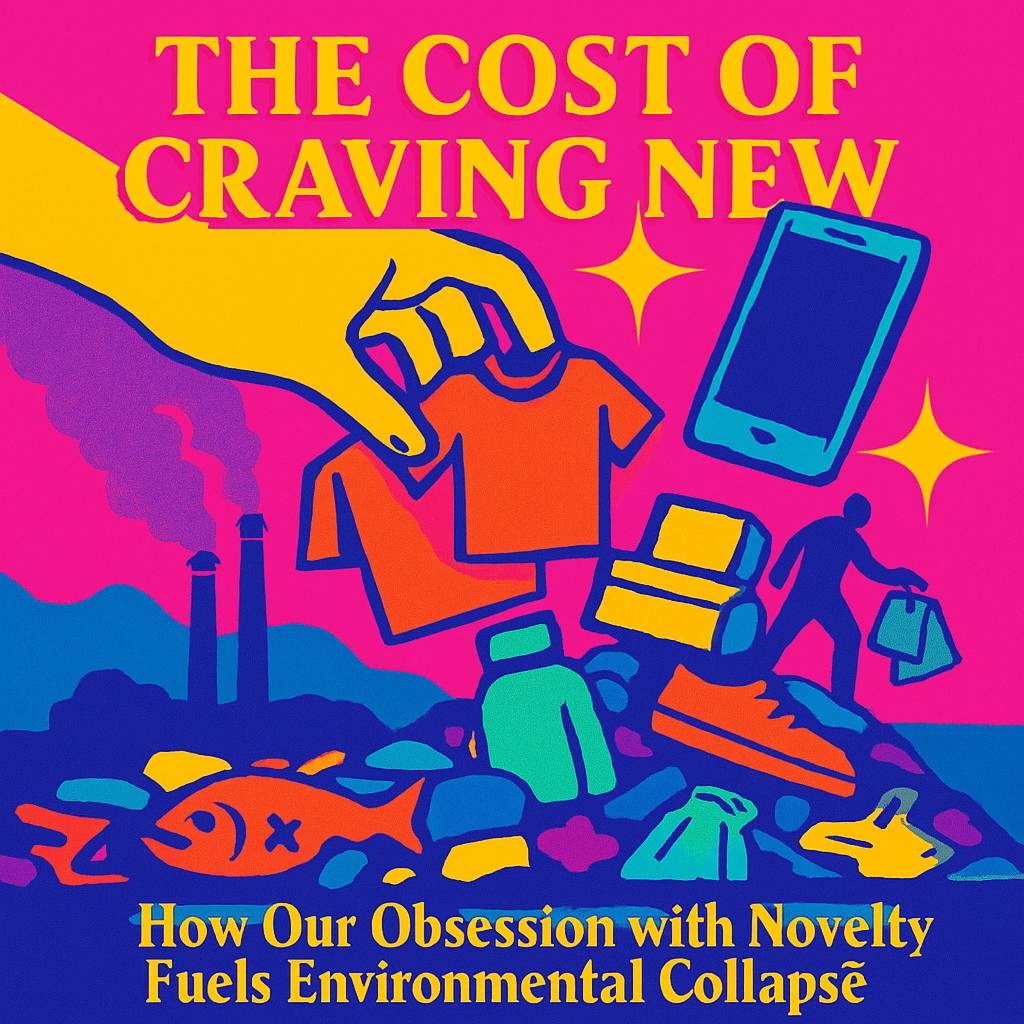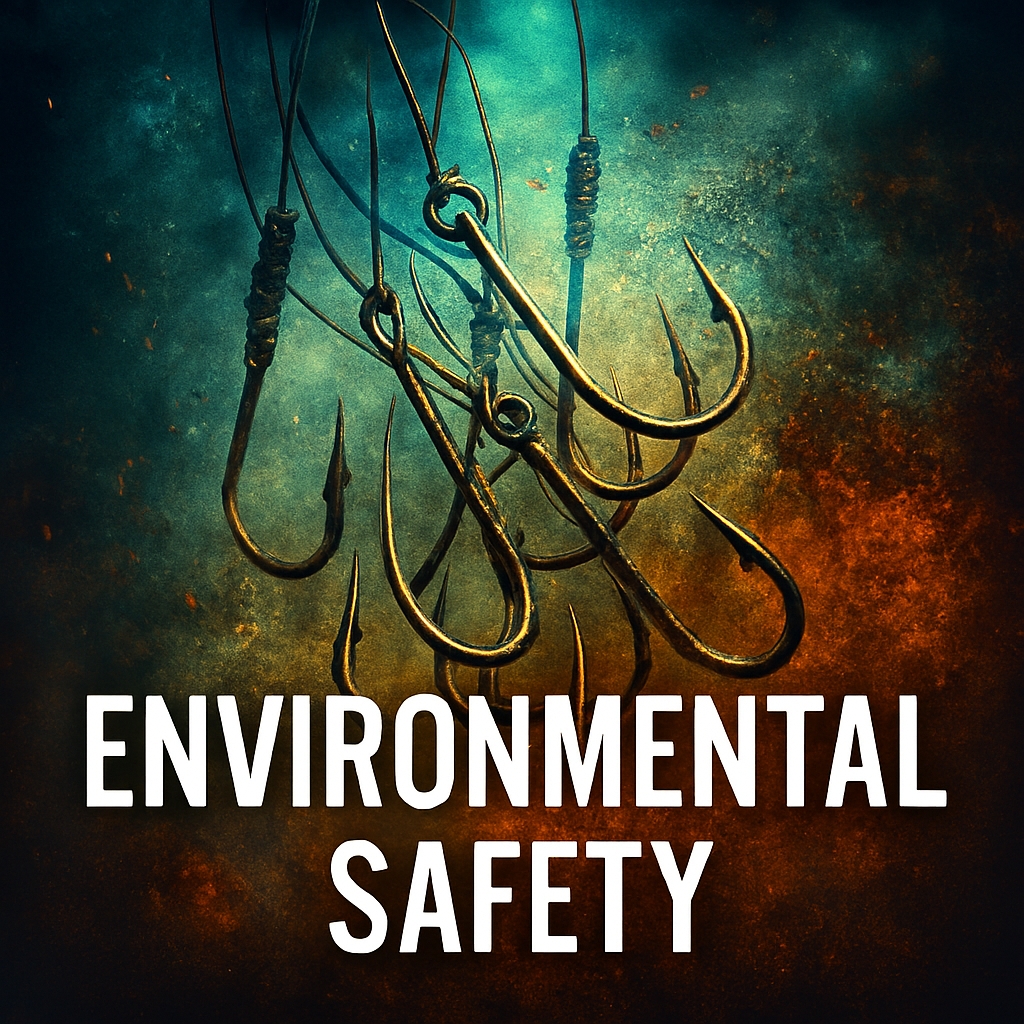How Our Obsession with Novelty Fuels Environmental Collapse
Why Rethinking Consumption Is No Longer Optional
Introduction — The Seduction of the New
From smartphones to seasonal fashion drops, our culture is addicted to novelty. This craving isn’t just psychological — it’s engineered by industries that profit from planned obsolescence and rapid turnover. The average consumer replaces their phone every 2.5 years, even though most devices remain functional for twice that time. Fast fashion brands now release up to 52 micro-seasons annually, encouraging constant wardrobe refreshes. Newness is marketed as progress, but its environmental toll is staggering. Manufacturing new products consumes raw materials, emits greenhouse gases, and generates toxic waste. The psychological reward of novelty is fleeting, but its ecological impact is long-term. Our desire for the latest model, the freshest trend, the next upgrade, is accelerating planetary degradation. Understanding this dynamic is essential to reversing it.
The Psychology Behind Novelty
Humans are biologically wired to seek novelty — a trait rooted in evolutionary survival. Dopamine levels spike when we encounter something new, reinforcing exploratory behavior. In modern consumer culture, this translates into compulsive buying and short attention spans. Marketing campaigns exploit this neurological loop, framing new products as emotionally rewarding. Social media algorithms amplify novelty-seeking by favoring fresh content over depth. This creates a feedback loop where novelty becomes synonymous with value. As a result, permanence is seen as stagnation, and disposability becomes normalized. Our brains crave stimulation, but the environment pays the price. Breaking this loop requires a conscious redefinition of what we value.

Planned Obsolescence — Built to Break
Planned obsolescence is a design strategy that intentionally shortens product lifespans. Electronics are often built with non-replaceable batteries or software updates that slow performance, forcing consumers to upgrade prematurely. The fashion industry uses low-quality materials that degrade quickly, encouraging frequent purchases. Appliance manufacturers limit repairability, making replacement more attractive than fixing. These practices boost sales but also generate massive waste and emissions. Globally, electronic waste exceeds 50 million tonnes annually, much of it ending up in landfills or exported to countries with unsafe recycling practices. Planned obsolescence is not innovation — it’s engineered waste. Reversing this trend requires systemic design reform and consumer awareness.
Fast Fashion’s Environmental Toll
It produces around 10 percent of global carbon emissions — more than international flights and maritime shipping combined. Textile production consumes vast amounts of water, with a single cotton shirt requiring approximately 2,700 liters. Synthetic fibers shed microplastics that contaminate oceans and enter the food chain. Garments are often dyed with toxic chemicals, polluting rivers in manufacturing hubs. Over 85 percent of textiles end up in landfills or incinerators. Workers in fast fashion supply chains face poor conditions, low wages, and exposure to hazardous substances. The speed of production sacrifices sustainability for profit. Slowing down fashion is essential to ecological recovery.
E-Waste and the Digital Dilemma
Electronic waste is the fastest-growing waste stream globally. Smartphones, laptops, and tablets contain rare earth metals mined under environmentally destructive conditions. Recycling rates for e-waste remain below 20 percent, with most devices discarded improperly. Toxic components like lead, mercury, and cadmium leach into soil and water, posing serious health risks. Informal recycling in developing countries exposes workers to hazardous materials without proper protection. The push for constant upgrades drives unnecessary disposal and resource depletion. Cloud computing and data centers also consume massive energy, often powered by fossil fuels. Digital convenience masks physical consequences. Sustainable tech design and circular systems are urgently needed.

Packaging — The Hidden Polluter
Packaging accounts for a significant portion of global waste. Single-use plastics dominate food and consumer goods, with over 300 million tonnes produced annually. Most plastic packaging is not recycled and ends up in oceans or landfills, where it persists for centuries. Cardboard and paper packaging contribute to deforestation and water use, especially when sourced unsustainably. Excessive packaging is often used for marketing appeal rather than product protection. Biodegradable alternatives exist but remain underutilized due to cost and infrastructure limitations. Packaging waste clogs ecosystems, harms wildlife, and releases methane when decomposing. Consumer demand for aesthetic packaging fuels this cycle. Redesigning packaging systems is critical to reducing environmental harm.
Transportation of the New
Global supply chains rely heavily on fossil-fueled transport to deliver new goods. Cargo ships emit sulfur oxides, contributing to acid rain and respiratory issues. Air freight has a disproportionately high carbon footprint, often used for fast delivery of consumer items. Trucks and delivery vans increase urban emissions and traffic congestion. Just-in-time logistics prioritize speed over sustainability, leading to inefficient routing and excess packaging. Warehousing and distribution centers consume energy and land, often displacing natural habitats. The environmental cost of transporting novelty is rarely considered in product pricing. Local production and slower delivery models offer more sustainable alternatives. Rethinking logistics is part of rethinking consumption.
Resource Extraction and Novelty
New products require raw materials that are often extracted unsustainably. Mining for metals destroys habitats, pollutes water sources, and displaces communities. Oil extraction for plastics contributes to climate change and risks catastrophic spills. Logging for paper and packaging reduces carbon sinks and biodiversity. Agricultural land is diverted from food production to grow non-essential crops for consumer goods. Resource extraction is frequently outsourced to regions with weak environmental protections and labor standards. The pursuit of novelty drives demand for finite resources, accelerating ecological collapse. Regenerative sourcing and material innovation are essential to reversing this trend. Without change, novelty will exhaust the planet.

The Myth of Recycling
Recycling is often presented as a solution, but its limitations are significant. Many materials degrade in quality after recycling, requiring virgin inputs to maintain performance. Contamination and poor sorting reduce the efficiency of recycling systems. Plastic recycling rates are especially low, with most plastics ending up incinerated or dumped. E-waste recycling is complex and hazardous, requiring specialized facilities and safety protocols. Fashion recycling is minimal, as most textiles are unsuitable for reuse due to mixed fibers and dyes. Recycling infrastructure varies widely by region, creating confusion and inefficiency. Overreliance on recycling distracts from the need to reduce consumption. True sustainability begins with less production, not better disposal.
Greenwashing — The Illusion of Progress
Greenwashing misleads consumers into believing products are environmentally friendly. Vague labels like “eco” or “natural” often lack regulation and verification. Companies use sustainability as a marketing tool while maintaining harmful practices behind the scenes. Carbon offsetting is frequently used to justify continued pollution without meaningful change. Limited-edition “green” products encourage more buying, not less. Transparency in supply chains is rare, making environmental claims difficult to verify. Greenwashing erodes public trust and slows real progress. Consumers must demand accountability, not aesthetics. Environmental integrity requires systemic change, not surface gestures.
The Role of Influencers and Trends
Social media influencers shape consumption patterns through curated novelty. Sponsored content promotes constant product turnover and aesthetic conformity. Viral trends encourage short-lived purchases that quickly fall out of favor. Influencer culture normalizes excess and disposability, especially among younger audiences. Platforms reward engagement metrics, not sustainability or depth. The pressure to stay “on trend” drives environmental neglect and emotional burnout. Ethical influencers are emerging, but they remain a niche presence. Digital platforms must evolve to support long-term values and responsible storytelling. Cultural leadership must shift from novelty to meaning.
Psychological Burnout from Consumption
Constant novelty leads to decision fatigue and emotional exhaustion. The pressure to keep up with trends creates anxiety and dissatisfaction. Possessions accumulate without purpose, cluttering both physical and mental space. The dopamine hit from new purchases fades quickly, requiring more stimulation to maintain interest. Consumption becomes a coping mechanism rather than a source of joy. Environmental guilt compounds emotional strain, especially among conscious consumers. Mindful consumption offers psychological relief and ecological benefit. Slowing down restores clarity, connection, and intentionality. Healing begins with deliberate choices and sustainable habits.

Indigenous Wisdom and Cyclical Thinking
Many Indigenous cultures emphasize cyclical relationships with nature and community. Objects are valued for utility, longevity, and symbolic meaning rather than novelty. Consumption is guided by seasonal rhythms and ecological awareness. Waste is minimized through reuse, repair, and respect for materials. Novelty is not prioritized over balance and sustainability. These systems offer powerful models for regenerative living and ethical stewardship. Western consumerism contrasts sharply with Indigenous approaches to resource use. Integrating traditional knowledge can inform modern solutions to environmental crises. Respecting cyclical wisdom is key to planetary healing.
Policy and Systemic Reform
Governments play a critical role in regulating consumption and production. Bans on single-use plastics and incentives for repair can significantly reduce waste. Extended producer responsibility shifts accountability to manufacturers for product lifecycles. Tax reforms can discourage planned obsolescence and overproduction. Public education campaigns help reshape cultural norms around consumption. Infrastructure for reuse, recycling, and repair must be expanded and standardized. International cooperation is essential to address global supply chains and environmental justice. Policy must prioritize ecological resilience over short-term economic growth. Systemic reform is the foundation of sustainable change.
Designing for Permanence
Designing products for longevity counters the culture of novelty and disposability. Modular electronics allow upgrades without full replacement, reducing waste and extending usability. Durable materials resist wear and degradation, minimizing the need for frequent replacements. Timeless aesthetics help products transcend trend cycles, encouraging emotional attachment and long-term use. Repairability empowers users to maintain their possessions rather than discard them. Open-source design fosters community innovation and collaborative problem-solving. Circular systems keep materials in use longer, reducing demand for virgin resources. Designers must consider the full lifecycle of a product, from sourcing to end-of-life. Permanence is not stagnation — it’s a form of ecological intelligence.
Reimagining Value
To shift away from destructive novelty, we must redefine what we consider valuable. Emotional resonance, ethical sourcing, and ecological impact should be central to our purchasing decisions. Products should tell stories, carry meaning, and reflect care in their creation. Communities can build economies around repair, reuse, and shared ownership. Artisanship and local production foster deeper connections between people and the objects they use. Slowness becomes a virtue, allowing time for reflection, appreciation, and sustainability. Value is no longer about speed or abundance, but about depth and integrity. Reimagining value transforms consumption into stewardship. The future depends on what we choose to honor — let it be substance over spectacle.

Conclusion — From Novelty to Necessity
Our love for the new is not inherently wrong, but its unchecked expression is ecologically catastrophic. The systems that feed this craving are designed for profit, not planetary health. Every product we discard, every trend we chase, leaves a footprint that outlasts its moment of excitement. Reversing this trajectory requires cultural, psychological, and systemic transformation. We must shift from novelty-driven consumption to value-driven stewardship. This means embracing permanence, cyclical thinking, and ethical design. It means slowing down, repairing, and reconnecting with the material world. The path forward is not about rejecting innovation — it’s about aligning it with ecological truth. Only then can we build a future where newness no longer comes at the cost of the Earth.
Join the Discussion
How do you navigate the tension between innovation and sustainability in your own life? What practices help you resist the pull of constant novelty?
#SustainableDesign #CircularEconomy #SlowLiving #EthicalConsumption #EnvironmentalJustice #DigitalWaste #FastFashionCrisis #RepairCulture #ReimagineValue #ClimateAction #MindfulConsumption #IndigenousWisdom #GreenwashingExposed #PackagingWaste #PlannedObsolescence

















The Psychology of Me
[…] Most of us have an internal voice—a stream of thoughts, judgments, and commentary that runs throughout the day. This voice can be supportive, critical, anxious, or curious, depending on our emotional state and learned habits. Psychologists call this “self-talk,” and it plays a major role in shaping mood, motivation, and decision-making. The psychology of me looks at how these internal narratives form, how they’re influenced by past experiences, and how they can be reshaped through conscious reflection. Understanding our self-talk helps us separate fact from fear, and habit from choice. […]